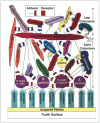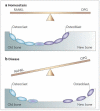Oral Microbes, Biofilms and Their Role in Periodontal and Peri-Implant Diseases
- PMID: 30248991
- PMCID: PMC6213094
- DOI: 10.3390/ma11101802
Oral Microbes, Biofilms and Their Role in Periodontal and Peri-Implant Diseases
Abstract
Despite many discoveries over the past 20 years regarding the etio-pathogenesis of periodontal and peri-implant diseases, as well as significant advances in our understanding of microbial biofilms, the incidence of these pathologies still continues to rise. This review presents a general overview of the main protagonists and phenomena involved in oral health and disease. A special emphasis on the role of certain keystone pathogens in periodontitis and peri-implantitis is underlined. Their capacity to bring a dysregulation of the homeostasis with their host and the microbial biofilm lifestyle are also discussed. Finally, the current treatment principles of periodontitis and peri-implantitis are presented and their limits exposed. This leads to realize that new strategies must be developed and studied to overcome the shortcomings of existing approaches.
Keywords: biofilms; oral bacteria; peri-implantitis; periodontitis.
Conflict of interest statement
The authors declare no conflicts of interest.
Figures






References
Publication types
LinkOut - more resources
Full Text Sources
Other Literature Sources
Miscellaneous

